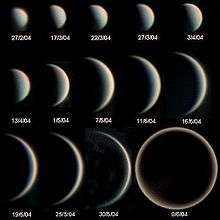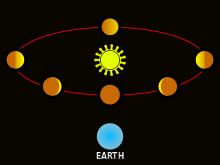Phases of Venus

The phases of Venus are the different variations of lighting seen on the planet's surface, similar to lunar phases. The first recorded observations of them were telescopic observations by Galileo Galilei in 1610. Although the extreme crescent phase of Venus has been observed with the naked eye, there are no indisputable historical pre-telescopic records of it being observed.[1]
Observation
The phases of Venus result from the planet's orbit around the Sun inside the Earth's orbit giving the telescopic observer a sequence of progressive lighting similar in appearance to the moon's phases. It presents a full image when it is on the opposite side of the Sun. It shows a quarter phase when it is at its maximum elongation from the Sun. Venus presents a thin crescent in telescopic views as it comes around to the near side between the Earth and the Sun and presents its new phase when it is between the Earth and the Sun. Since the planet has an atmosphere it can be seen at new in a telescope by the halo of light refracted around the planet. The full cycle from new to full to new again takes 584 days (the time it takes Venus to overtake the Earth in its orbit). The planet also changes in apparent size from 9.9 arc seconds at full (superior conjunction) up to a maximum of 68 arc seconds at new (inferior conjunction).[1] Venus reaches its greatest magnitude of −4.5 when it is an intermediate crescent shape at the point in its orbit, when it is 68 million km away from the Earth (a combination of its closeness and the fact that it is 28% illuminated).[2]
History

The first known observations of the full planetary phases of Venus were by Galileo at the end of 1610 (though not published until 1613 in the Letters on Sunspots). Using a telescope, Galileo was able to observe Venus going through a full set of phases, something prohibited by the Ptolemaic system. (The Ptolemaic system would never allow Venus to be fully lit from the perspective of the Earth, as this would require it to be on the far side of the sun, which is impossible if Venus's orbit in its entirety is between the Earth and the sun, as the Ptolemaic system requires[3]). This observation essentially ruled out the Ptolemaic system, and was compatible only with the Copernican system and the Tychonic system and other geoheliocentric models such as the Capellan and Riccioli's extended Capellan model.
Naked eye observations
The extreme crescent phase of Venus can be seen without a telescope by those with exceptionally acute eyesight, at the limit of human perception. The angular resolution of the naked eye is about 1 minute of arc. The apparent disk of Venus' extreme crescent measures between 60.2 and 66 seconds of arc,[4] depending on the distance from Earth. Nevertheless it is possible for observers with extremely acute eyesight to see a crescent Venus under ideal atmospheric circumstances.
There have been numerous reports stating such observations. The phases of Venus are alleged to have been seen in Mesopotamian times by priest-astronomers. Ishtar (Venus) is described in cuneiform text as having horns.[1] However, other Mesopotamian deities were depicted with horns, so the phrase could have been simply a symbol of divinity.
See also
Notes
- 1 2 3 Goines, David Lance (October 18, 1995). "INFERENTIAL EVIDENCE FOR THE PRE-TELESCOPIC SIGHTING OF THE CRESCENT VENUS". Retrieved 2010-08-11.
- ↑ souledout.org - Venus Has Phases ... Like the Moon
- ↑ Galileo's observations of the phases of Venus (slide 4)
- ↑ Williams, David R. (April 15, 2005). "Venus Fact Sheet". NASA. Retrieved 2007-10-12.
References
- Campbell, William Wallace (1916). "Is the Crescent Form of Venus Visible to the Naked Eye?". Publications of the Astronomical Society of the Pacific. 28: 85–86. Bibcode:1916PASP...28...85C. doi:10.1086/122498.
- Reinhardt, Carl (1929). "Notes and Queries: Phase of Venus seen with the Naked Eye". Journal of the Royal Astronomical Society of Canada. 23: 48–49. Bibcode:1929JRASC..23...48C.
- Goines, David Lance (1992). "Observer's Notebook: Naked Eye Crescent of Venus". Sky & Telescope. 83.
External links
- Observations and Theories of Planetary Motion
- The crescent Venus seen with the naked eye
- Owen Gingerich - Empirical proof and/or persuasion — lecture on Galileo's observation of the phases of Venus from a renowned historian of science
- YouTube animation of the phases of Venus predicted by the pure geocentric Ptolemaic model
- YouTube animation of the phases of Venus predicted by the heliocentric model (and implicitly also by the geo-heliocentric models such as the Tychonic)

